Bugs on the beach can sometimes bite. They can simply be bothersome on other occasions.
Correct species identification is important as you know which bug bites and which doesn’t.
The beach provides an ideal habitat for digger species such as digging bees which use soft sand to build nests.
They also offer high humidity and puddling water ideal for species that lay eggs in water, such as mosquitoes.
Beaches can also be rich in food sources such as algae and rotting fish.
Staying away from bugs on the beach is essential to avoid bites.
Using anti-insect sprays and properly storing food while at the beach are among the common preventive measures against insect and bug bites.
Table of Contents
23 Common Bugs Found On The Beach
The following species of bugs and insects are most likely to be spotted on beaches in the summer.
1. Sand Fleas

Beach hoppers, sand hoppers, and beach fleas are other names for sand fleas.
Hopping and escaping capture, these types of fleas aren’t insects but crustaceans.
Most of these fleas grow up to a size of 1 inch.
Coloring differs with the species. They can be white, tan, gray, green, or brown.
These types of crustaceans can bite. They rarely lead to serious conditions following their bites since these bites aren’t venomous or poisonous.
Sand Flies can also travel back home attached to clothes. These types of crustaceans cannot survive or mate inside the house.
Sand Fleas are always found in moist areas around the beach. This includes sheltered areas with moisture such as the space under rocks or logs.
While they can travel away from these sites, Sand Fleas always return in hiding spots.
Some types of Sand Fleas might be nocturnal, only coming out at night to avoid having to face direct sunlight and low air humidity.
2. Sand Flies

Sand flies are small insects encompassing 2 insects under an informal name.
Species under the broad category of sandflies can be horseflies or no-see-ums in the US.
Sand flies might also be a colloquial name given to other small black flies that bite and live on the beach.
These tiny flies that are barely visible come with wings and they can suck blood.
While viruses transmitted by these flies are rare in North America, they can be vectors for disease transmission in South America.
This species has been linked with Carrion’s Disease, an infectious disease that causes largely inflamed and infected skin in the bitten area or elsewhere on the body.
These flies are less likely to cause considerable adverse reactions when biting people in the US. Analgesics might be sufficient to control possible adverse reactions of the flies.
Not all sand flies bite, on the other hand. It’s only the females that bite as they need a blood meal to lay eggs.
3. Beach Wolf Spiders
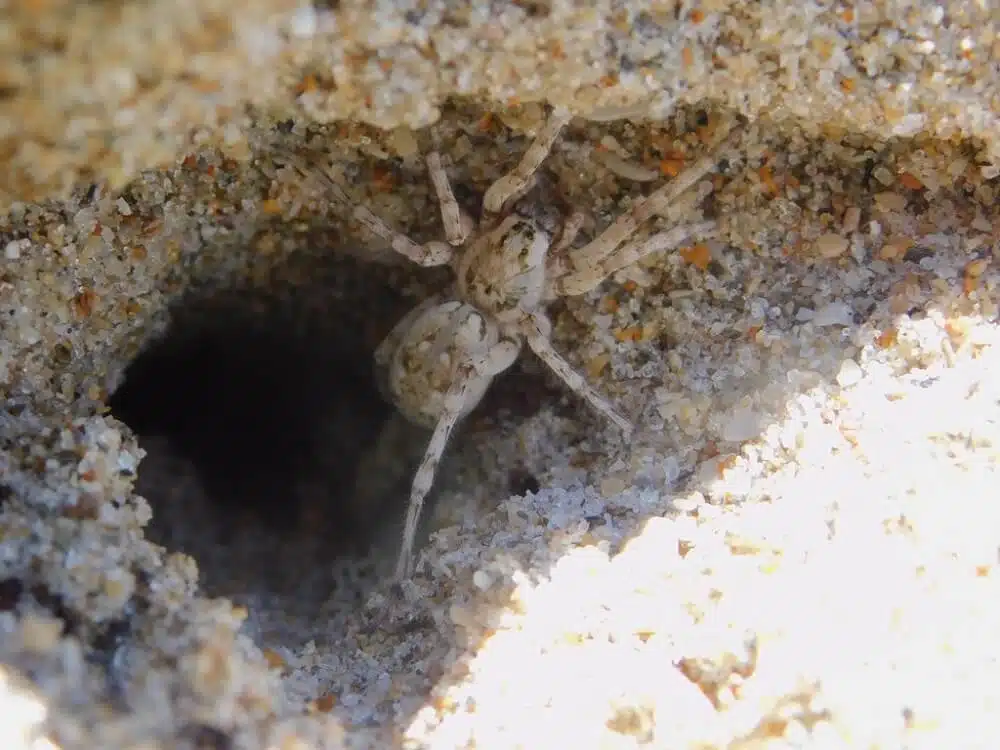
Beach Wolf Spiders are barely visible based on their gray, tan, and brown colors.
The color of the species reflects the color of its sandy environment. Beach Wolf Spiders are a species common in coastal areas across The US and Canada.
These spiders don’t spin spider webs but actively look for prey such as small insects and small bugs.
Hunting techniques often involve patiently waiting for insects and small bugs to come to a close distance before directly jumping on the small prey.
Spiders of this family may bite. These bites aren’t venomous but they can be slightly painful.
A rare occurrence, the bites happen when the species is roughly handled.
Most Beach Wolf Spiders spend their days hiding when not looking for food.
Hiding spots such as those in driftwood or under rocks are preferred for their quick gateways.
A small species that only grows to a maximum of 0.6 inch size, this type of spider also uses its camouflaging colors to escape predators.
It may stay still for predators to overlook it.
Female Beach Wolf Spiders can be seen carrying spiderlings or young spiders on their body as these are the types of species that carry the young as they hatch.
Driftwood is one of the most common hiding areas for these types of spiders.
They make the most of their bright camouflaging colors to simply hide in plain sight.
This is one of the main reasons both children and adults should stay away from driftwood as it can be the temporary home of spiders, ants, larvae, and other bug species.
4. Jumping Spiders
Jumping spiders are a species of spiders that pounce on prey rather than build large spider webs.
These types of spiders live in almost all habitats from sea level to altitudes of thousands of feet.
Multiple species with a large variety of colors are specific to this large group of a spider.s
Beach Bum jumping spider (Saitis sp.)

Native to Oceania, this is a spider species with black, gray, and tan colors.
It often mimics the coloring of its habitat which represents beaches with a mix of pebbles and sand. The spider jumps distances a few times its own body length.
Hakka himeshimensis

This type of spider has dark brown to black body colors. A native Asian spider, the species has been introduced in North America.
Its established populations are mostly found on rocky beaches.
It jumps on pebbles for prey and it also makes a quick escape under rocks whenever threatened.
5. Isopods
Isopods are generally aquatic crustaceans with an important role in the ecosystem by decomposing plant matter.
A few terrestrial isopods can also be seen on dry land, particularly on beaches.

Some of the multiple hopping bugs on beaches are Sandhoppers (Talitrus saltator). The species gets its name from its constant and somewhat erratic jumping movements.
This species of terrestrial isopods has spread throughout many parts of Europe and North America.
The color of the species is tan to brown, often mimicking the color of the sand. Growing to a size of up to 0.6 inches, this is a species with a dark back, long antennae, and small black eyes.
These types of isopods cannot bite.
A burrowing species, the bug makes its way into the sand to hide and to find moisture.
Young Sandhoppers cannot burrow. This is why most juvenile Sandhoppers are actually killed by water tide.
The species is nocturnal and rarely seen by people unless found under rocks or driftwood.
Sandhoppers can jump a few times their height. Research shows these bugs don’t have a clear direction when jumping as jumping spiders.
Adult Sandhoppers can also navigate waters at night, mainly by assessing their location in relation to the location of the moon.
6. Rove Beetles
Rove Beetles are adapted to living next to oceans and on beaches. It lives in areas exposed to tides.
North America and Europe are common natural habitats for Rove Beetles.
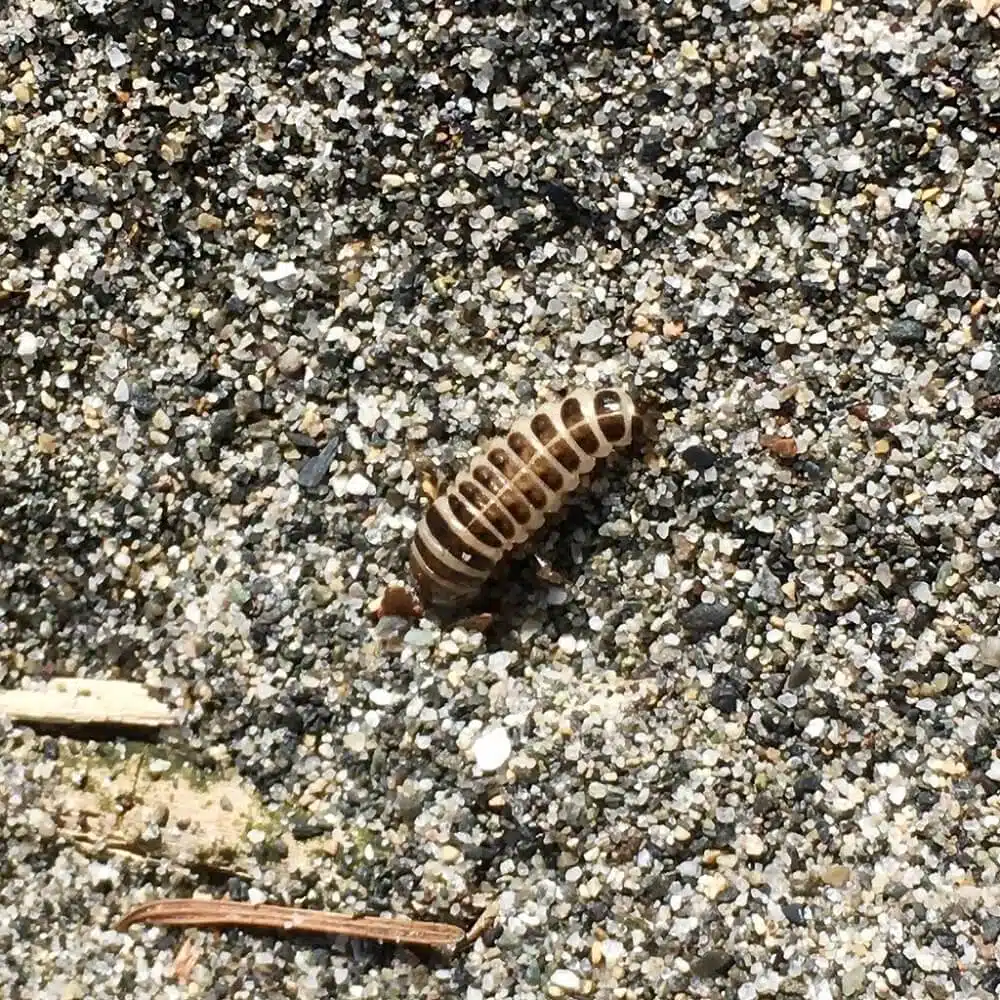
Pictured Rove Beetles are among the common types of Rove Beetles in North America. They are only present in coastal areas both for habitat and for food.
This beetle only eats other types of insects and bugs on beaches next to oceans.
Pictured Rove Beetles feed almost exclusively on Beach Hoppers.
Isopods on beaches are also part of their diet but to a lesser extent.
Small differences in feeding and activity habits are also noted for the species. Females eat more than males and they’re also more active.
Rove Beetles are nocturnal and known to come out of their sand burrows for food at night.
They have different hunting techniques which include ambushing by waiting for prey patiently or actively going out for Beech Hoppers.
7. Kelp Flies

Kelp Flies are some of the most annoying species found on the beach.
Also known as the Seaweed Fly, Kelp Flies are only present on beaches with sufficient seaweed used for food.
The species is one of the smallest brown flies on beaches. Its reduced size also makes it a common target for predators.
Small birds consume Kelp Flies but without much impact on their populations.
While they don’t bite, Kelp Flies can be annoying. They can be blown into cities from beaches on days with high winds.
Kelp Flies also show better adaptations and higher survival rates with tides compared to other bugs on beaches.
Short hairs on their bodies trap air bubbles which means the fly always surfaces on top of the water even when surprised by tides.
The population of Kelp Flies depends on seaweed but it’s also affected by temperature.
Higher seaweed decomposition rates lead to reduced nutrition and food availability for these flies.
As a result, years with cooler summers tend to support seaweed and higher Kelp Fly populations.
Male Kelp Flies are known to overpower smaller females which typically only have one mate.
8. Mosquitoes
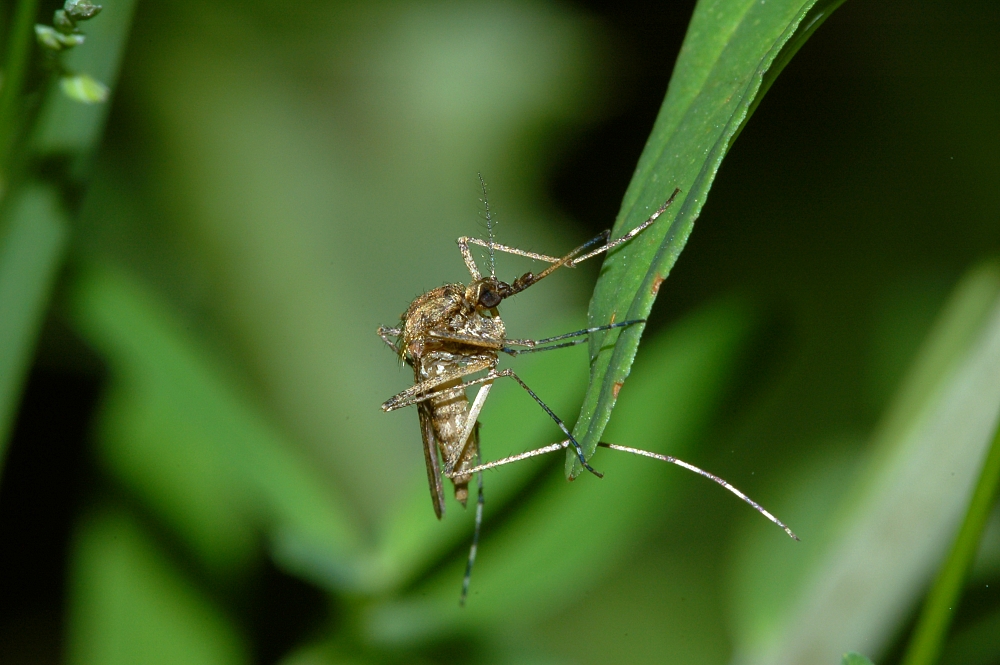
Many people believe mosquitoes can’t survive on beeches for long. This is false as mosquitoes can thrive on beeches.
They lay eggs in freshwater but they can also lay eggs in saltwater as well.
As a result, mosquitoes and other flies such as no-see-ums live on beeches.
They can be attracted by lights on the beach but they can also make their way to areas with puddling water to lay eggs in.
Homes on beaches are the most exposed to mosquito invasions as these flies are attracted to light at night.
Popular beaches are more likely to be homes for mosquitoes as they have people and animals around.
Female mosquitoes need blood meals to lay eggs.
Aedes mosquitoes are known to lay eggs directly on beaches. Sand that gets some moisture is preferred so it’s likely mosquito eggs are laid closer to water.
Homes with swimming pools, plenty of trash and vegetation, or homes with standing water in the garden close to beaches are the most likely to attract mosquitoes.
9. Bed Bugs

Bed Bugs are one of the most atypical bugs on the beach. Seeing your towel or clothes is a major alarm.
Bed Bugs don’t live on the beach. They live indoors and seeing one on your personal items rings alarm bells you might already have them in the house.
The only way for Bed Bugs to be present on the beach is if someone from an infested home brings them along.
Bed Bugs are some of the most problematic species when it comes to their impact on homes.
They suck blood and they often infest beds, carpets, and other textiles around the house.
Almost all of the infested items should be thrown away.
Seeing Bed Bugs on yourself or on items you own on the beach is a time you need a proper home inspection when you’re back.
Beds, armchairs, and carpets are common areas of the home to start looking for bed bugs.
Serious invasions can mandate the need to get professional pest controllers to eliminate the species.
10. Tiger Beetles
Tiger Beetles are often seen on beaches where they have adapted in coloring and food preferences.
Like some of the larger types of bugs, you can find on the beach, Tiger Beetles come in white or gray-to-white colors with contrasting black marks.
This is a species that doesn’t bite and which prefers to flee when seeing humans.
Touching these types of bugs isn’t recommended either. They can spread various viruses and bacteria as Tiger Beetles can be eating dead fish and other dead animals on the beach.

Some of the common Tiger Beetles of North America are Northeastern Beach Tiger Beetles (Cicindela dorsalis).
This is a species found in areas of the beach closest to the water as this is where different types of flies and larvae are for them to feed.
Mosquitoes and their eggs are found here.
Killing these bugs isn’t recommended as they’re seen as an endangered species in most North American habitats.
11. Ground Beetles

Ground Beetles come in multiple subspecies, some of them living exclusively on the beach.
One such example is the Round Sand Beetle. This is a species with a small body and a round shape.
A black and brown body is specific to this beetle which lives all around the world in the Northern Hemisphere.
12. Bristle Worms
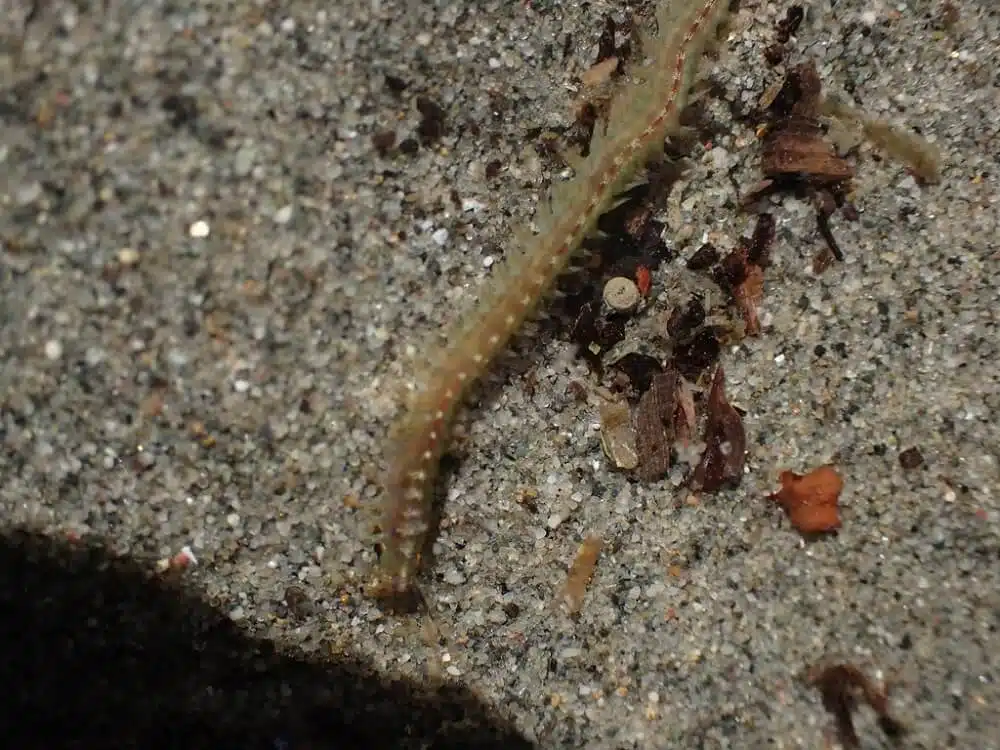
Bristle Worms are some of the most elusive yet resilient species of worms found in oceans.
This species is particularly known for its resistance to some of the coldest oceans or to high depths.
The worm may wash up on beaches occasionally.
Hundreds of Bristle Worms exist around the world. Both herbivorous and carnivorous species exist.
While rare, these worms may bite when found alive on beaches.
13. Love Bugs
Some of the most common types of bugs around The Gulf of Mexico beaches are Love Bugs.
This species is named after the tandem flight of the bugs which remain together and even fly together after mating.
While love bugs may look threatening, these bugs are only nuisance pests.
These black bugs don’t bite or sting.
14. Horse Flies

Sunny areas on beaches are ideal habitats for Horse Flies. These types of large insects don’t like flying in shaded spots such as woodlands.
They need direct warmth from sunlight.
These flies also need blood which means it bites both animals and humans.
Bites of these flies are highly painful. It’s only the female Horse Flies that bite, as they need a blood meal just before laying eggs.
15. Spotted Lanternflies

Spotted Lanterflies are some of the most common nuisance pests in certain areas of the world.
This is an invasive species in North America.
While it has very large wings, it prefers to hop from one plant to another for food.
It might be found around beaches if it finds sustainable food sources in the area.
You can identify Spotted Lanternflies by their vivid red hindwings and by their tiny black spots on the forewings.
16. Ladybugs

Most ladybugs are predators, unlike Spotted Lanternflies.
They fly looking for suitable prey such as aphids and aphid eggs. They might end up on beaches carried by wings.
Colorful ladybugs can also end up on beaches surrounded by plants aphids like to eat.
Plants with soft leaves that offer easy-to-access juices around beaches are most likely to attract aphids and ladybugs altogether.
17. Bees
Bees are some of the most common types of bugs you may find on beaches.
Many solitary or social digger bees are found on beaches as they find it easy to dig their nests in the ground.
These nests can be small or large, measuring up to tens of inches when coming with different chambers.
Digger bees use the soft sand on the beach to dig a nest, rest, or lay eggs.
This type of bee mimics local bee populations.
These fuzzy bees are important pollinators of many types of plants only living on beaches.
Found in Northeastern US habitats, these bees as well as other bees are interested in plants such as sea rocket plants, a type of mustard mainly found on sandy terrains on beaches.
These plants have violet colors and tend to attract a large number of bees.
Killing bees on the beach is not recommended given many have a positive role in the ecosystem as true pollinators.
Ensuring you sunbathe away from bee nests and away from plants rich in nectar are some of the best preventive measures to avoid having to deal with bee stings.
18. Wasps

Just like bees, wasps can also be present in beeches. Wasps may also have a small pollinator role but many can also come with a painful sting.
Seeing a long stinger at the tip of the abdomen is the first sign of a potentially-painful wasps species.
Sand wasps in the species of Crabronidae are often seen on sandy soils. They create thousands of nests on undisturbed beaches.
These types of wasps are true carnivores as juveniles. Adults provision different types of flies for the emerging wasps back in the nest.
They can also sting if provoked.
Some types of Crabronidae wasps never sting. However, stepping on them or their nests is seen as an act of aggression and it may be followed by a stinging attempt.
Beaches, where there’s not much human activity, tend to attract the most wasps as these are areas where digger wasps can easily dig multiple nests.
Wasps on beaches might also make it indoors in homes on beaches looking for food.
Insects such as The Common House Fly can attract plenty of wasps indoors.
Spiders can also attract predatory wasps indoors.
It’s best to keep doors and windows closed at night and to check the quality of the mesh screens on windows to keep wasps and other flies that attract wasps out.
19. Blood Worms

Blood Worms are known to bite. They have a faded pink color and live in shallow marine waters.
A large head in relation to the body helps identify these worms. The species may reach a size of up to 14 inches but most measure around 10-12 inches.
The species is carnivorous and it also uses venom against its prey.
While not lethal to humans, their venomous bites are very painful.
This species of worm is mostly found in the Northeastern parts of the US.
Bloodworms may end up biting those going for a quick dip on the beach. But the species also has plenty of natural predators as well.
Fish are the main predator of bloodworms. Gulls are also known to actively fly over shallow water to snatch bloodworms.
Summertime marks the period most people are bitten by the species as the weather is warm and bloodworms are more aggressive and highly active.
Periods from the end of June to the beginning of August mark the mating season for these types of worms and also the time when they are most likely to bite.
20. Ants
Multiple species of ants can infest beaches. Some of these bite while others don’t.
Florida, California, and Virginia are among the states with multiple cases of ant invasions reported on beaches.
Argentine Ants are among the common species to be found on beaches. However, there are many other types of ants that you may encounter on sandy soils next to the ocean.
- Acrobat Ants

These types of ants (Crematogaster ashmeadi) are dangerous on beaches as they can bite.
The name of the species is inspired by the ability to raise the abdomen above the thorax.
You can identify them by their dark brown color and the unpleasant odor they release when disturbed.
- Ghost Ants
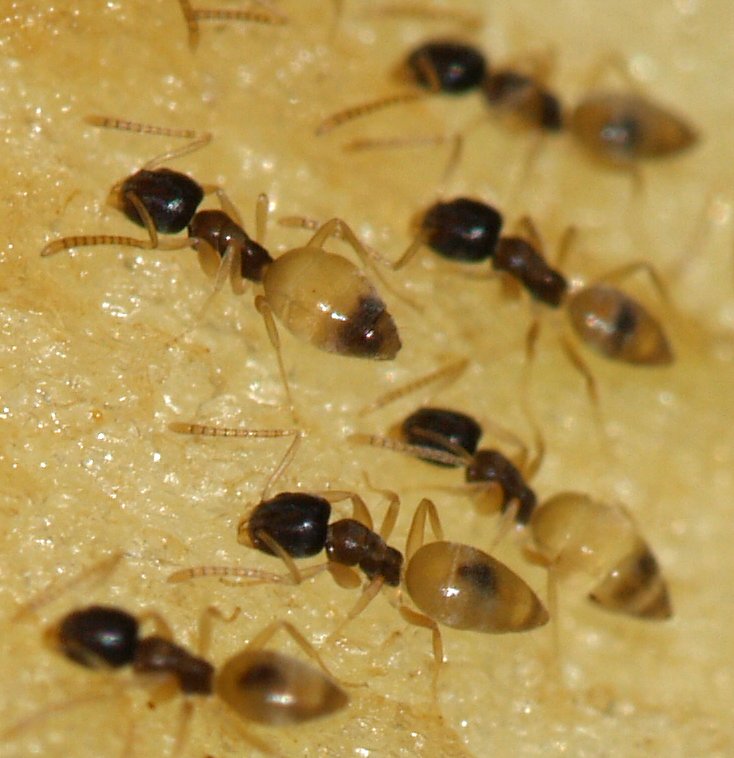
Ghost Ants (Tapinoma melanocephalum) are some of the most difficult ants to spot on beaches given they have a pale color. These ants have a pale yellow-white and brown body color and a very small size.
Most Ghost ants measure around 1.3mm.
Beaches with old rotting wood around tend to house these types of ants as they create nests inside decaying wood.
- Fire Ants

These types of ants (Solenopsis invicta) are most common on Southwestern US beaches. It’s here that the species lives underground.
These types of ants can attack in large numbers. They can swarm and bite on occasion.
While small, these tiny brown ants have a strong bite sticking their small jaws deep into the skin.
- Carpenter Ants
As some of the largest ants, Carpenter Ants (Camponotus spp.) can sometimes measure up to 1 inch. They come in red, brown, and red-brown colors.
These types of ants nest in wood and they can bite if their nest is disturbed.
21. No see ums

No-see ums are some of the most problematic types of flies on the beach.
These flies are so small that their size inspires their name. No see ums sometimes only measure 1mm as adults.
These are flies with transparent wings, adapted to bite. They can live next to the ocean or they can be completely terrestrial, living further inland.
One of the biggest problems with no see ums is their size which allows them to get through standard window mesh screens or through tent mesh doors.
No see ums are some of the most problematic flies attracted to light at night.
They can make their way into tents on the beach or into homes on the beach.
No see ums may also attack without provocation, especially exposed areas of the skin.
These types of biting flies may be spotted in areas of the beach with still water.
This is an area with mosquito larvae, one of the favorite foods of no see ums.
Flies of this family can attack people in these areas. They have scissoring mouthparts adapted to cutting skin. While injuries from the bites aren’t severe to humans, they are still highly painful.
22. Cicadas

Cicadas are some of the atypical types of insects found on beaches. These flies don’t bite or sting, but they can be annoying.
Not all cicadas are seen every year. There are 2 types of cicadas.
Annual and periodical cicadas are found on beaches around the world. It’s the annual species that appear every summer on beaches and along coastlines.
Found in different colors, cicadas are often black with colored eyes and wings.
They don’t have usable mouthparts such as other types of flies. They only have adapted mouthparts to drink the liquid tree sap.
These types of insects don’t drink blood.
Cicadas cans sometimes are eaten by children, by mistake. This isn’t known to cause any concerns for parents as they can be consumed, similarly to crickets.
Some cicadas might follow you on the beach, albeit on rare occasions.
They are most likely interested in trees and areas with dense vegetation.
This is one of the reasons why cicadas might make their way to beaches close to woodlands or beaches surrounded by thick vegetation.
23. Crickets

Crickets are some of the most common omnivore bugs on the beach.
These bugs have a varied diet which allows them to survive and thrive on beaches.
They eat all types of plants as well as plant seeds, together with insect and insect larvae.
The larvae of mosquitoes and other types of flies attract crickets to the beach.
Many types of beaches surrounded by vegetation are the most likely to attract crickets.
While omnivores, crickets often rely on vegetation as the bulk of their diet and for running away.
They hide in tall vegetation whenever they need to escape a predator.
Crickets are also among the beach bugs that eat fruit and may be attracted to the open fruits you bring to the beach.
It’s best to avoid carrying open fruits to the beach as they attract both flying insects and crawling bugs.
Atlantic Beach Crickets are among the species known to have a pale brown or even tan color which makes them difficult to spot on the beach.
These bugs take on the color of beaches so that they avoid predators.
Like other species of crickets, Atlantic Beach Crickets look constantly look for food which means they can cover large distances on the beach.
While they don’t bite, crickets can still be annoying on the beach.
You can identify crickets by their jumping movements over other species. They jump distances a few times their size making a quick escape when spotting predators.
Prevention tips to avoid bugs on the beach
Bugs on the beach can sometimes bite.
Food can attract them to your area but you might also be stepping into an area with plenty of bugs without knowing what to look for.
Choose clean beaches over beaches covered in vegetation
Clean beaches that are under the management of public authorities are less likely to have as many bugs as wild beaches.
Many bees nest on wild beaches, areas with reduced human activity.
Ants and other types of sand burrowers are also likely to live on beaches with plenty of economic and human activity.
If you’re known as a person with possible allergies to bugs and bug bites, it might be a good idea to simply move along to a public beach instead of favoring wild beaches.
Don’t sunbathe in areas around standing or puddling water
Puddling water and even moist sand or soil are ideal for many types of bugs.
These moist areas are ideal breeding grounds for mosquitoes and other bugs and flies you find on beaches.
You can find bugs on beaches like puddling bodies of water created by the rising tide.
Mosquitoes are known to use freshwater, saltwater, and brackish water to lay eggs.
Stay away from driftwood and rotting wood
Rotting wood on the beach might make for a great photo background, but it also houses different ants.
Species such as Carpenter Ants make large nests in rotting or decayed wood.
You may find most ants on the beach are nesting in a nearby piece of decaying wood.
Keeping children away from these areas is also important as they can also house different other types of bugs.
Spiders that eat ants can also be found in these areas. Some spiders can bite when handled.
Avoiding leaving open food accessible while on the beach
Food and sugary drinks are known to attract many types of bugs such as ants.
You might be enjoying a day at the beach when you find ants covering your open food such as fruit or an open juice bottle.
Even spilled juice on the sand or pebbles on the beach may attract ants and flies.
It’s best to keep food in containers when on the beach.
Families also need to ensure children aren’t eating fruits directly off the beach as these foods may already be contaminated by ants or other bugs.
Use DEET sprays
Sprays based on diethyltoluamide are ideal against bugs and insects.
These types of sprays or those based on picaridin are ideal for people looking to spend a day at the beach.
They are safe to use for adults and children and they might be the last line of defense against mosquito and bug bites.
Some beaches also allow barbecues and fires. Smoke acts as a natural repellent for bees, wasps, ants, and bugs.
A campfire on the beach might be one of the ideal methods of keeping bugs away, especially at night when mosquitoes and other nocturnal insects bite the most.